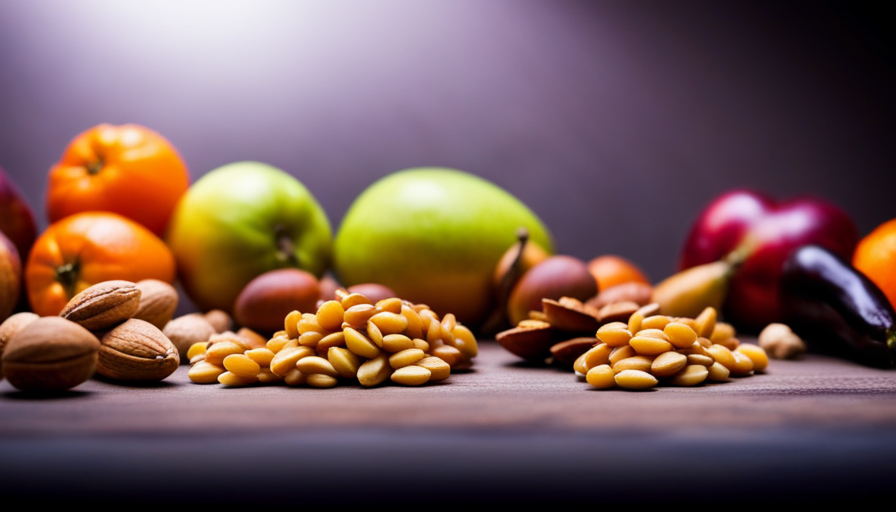Picture biting into a delicious, ripe apple, with its crunch and juice tantalizing your taste buds. Now, consider that same apple, unwashed and raw, hiding unseen dangers that could harm your health.
Raw food consumption may seem natural and healthy, but it can come with a host of risks that most people are unaware of. From bacterial contamination to parasitic infections and compromised nutritional value, the consequences of eating raw food can be severe.
In this article, I will delve into the various risks associated with consuming raw food, as well as the measures you can take to ensure your safety. So, if you’re a fan of raw food or considering incorporating it into your diet, read on to discover the potential pitfalls and explore alternative options for a healthier and safer culinary experience.
Key Takeaways
- Raw food consumption can lead to bacterial contamination and foodborne illnesses, causing symptoms like diarrhea, vomiting, and abdominal pain.
- Raw food, especially undercooked meats, seafood, and eggs, can be contaminated with harmful bacteria like Salmonella, E. coli, and Campylobacter.
- Raw food can also pose a risk of parasitic infections like Toxoplasma gondii and Trichinella spiralis, which can cause flu-like symptoms, muscle pain, and more severe complications in certain individuals.
- Proper handling and cooking of food is essential to prevent bacterial contamination, ensure food safety, enhance nutritional value, and reduce the risk of foodborne illnesses associated with raw food consumption.
Understanding the Risks of Raw Food Consumption
Understanding the risks of eating raw food can help you make informed decisions about what you put on your plate. Raw food consumption has gained popularity due to its perceived health benefits and the belief that it retains more nutrients compared to cooked food. However, it is important to be aware of the risk factors associated with consuming raw food.
One of the main risk factors is bacterial contamination. Raw food, especially meats, seafood, and eggs, can be contaminated with harmful bacteria such as Salmonella, E. coli, and Campylobacter. These bacteria can cause foodborne illnesses, resulting in symptoms like diarrhea, vomiting, and abdominal pain. In severe cases, they can lead to hospitalization and even death.
Another nutritional implication of eating raw food is the potential for nutrient deficiencies. Cooking can enhance the bioavailability of certain nutrients, making them easier for our bodies to absorb. For example, cooking tomatoes increases the release of lycopene, a powerful antioxidant. Similarly, cooking legumes helps break down compounds that can interfere with nutrient absorption.
Understanding these risk factors and nutritional implications is crucial for making informed choices about raw food consumption. By considering these factors, you can better protect yourself from bacterial contamination and ensure you are obtaining the necessary nutrients from your diet.
Moving forward, let’s delve into the topic of bacterial contamination in raw food without compromising our health.
Bacterial Contamination in Raw Food
Bacterial contamination lurks in every bite of uncooked food, waiting to unleash its potentially harmful effects on your digestive system. One of the main sources of bacterial contamination in raw food is undercooked meat. When meat isn’t cooked thoroughly, harmful bacteria like Salmonella, E. coli, and Campylobacter can survive and cause foodborne illnesses.
These bacteria can enter your body and wreak havoc on your digestive system, leading to symptoms such as diarrhea, vomiting, abdominal pain, and fever. Undercooked meat is particularly risky because it can contain higher levels of harmful bacteria compared to other types of raw food.
It’s important to handle and cook meat properly to kill any bacteria present. This includes using separate cutting boards for raw meat and other ingredients, ensuring meat is cooked to the appropriate internal temperature, and avoiding cross-contamination with other foods.
If you consume raw or undercooked meat, you’re putting yourself at a higher risk of developing foodborne illnesses. These illnesses can range from mild discomfort to severe complications, especially for individuals with weakened immune systems, children, and older adults. Therefore, it’s essential to cook meat thoroughly to prevent bacterial contamination and potential health risks.
Now, let’s explore the next section on parasitic infections from raw food.
Parasitic Infections from Raw Food
If you eat raw food, you can be at risk of parasitic infections such as Toxoplasma gondii and Trichinella spiralis. Toxoplasma gondii is a parasitic protozoan that can cause flu-like symptoms and more severe complications in people with weakened immune systems.
Trichinella spiralis is a parasitic roundworm that can cause muscle pain, fever, and swelling, and can be particularly dangerous if the larvae migrate to the heart or brain.
Toxoplasma gondii
Be careful when consuming raw food, as Toxoplasma gondii, a parasite that can invade your body and wreak havoc on your organs, may be lurking within. Toxoplasma gondii is a common parasite found in raw or undercooked meat, as well as unwashed fruits and vegetables. It can cause a condition called toxoplasmosis, which can lead to flu-like symptoms such as fever, muscle aches, and fatigue. In severe cases, it can even cause damage to the brain and other organs. Toxoplasmosis prevention is crucial, and one way to reduce the risk is by thoroughly cooking meat and washing fruits and vegetables before consumption. Cooking food not only kills parasites like T. gondii but also provides other health benefits, such as destroying harmful bacteria. Moving on to the next topic, another parasite that can be found in raw food is Trichinella spiralis.
Trichinella spiralis
Consuming raw food poses a grave risk as Trichinella spiralis, a parasite that can invade your body and cause excruciating pain, may be lurking within. Trichinella spiralis is a tiny worm that can be found in undercooked or raw pork, wild game, and other mammals.
When ingested, the larvae of Trichinella spiralis can penetrate the small intestine and migrate to various organs, including the muscles. This can lead to symptoms such as muscle pain, fever, swelling, and weakness. In severe cases, it can even cause heart and breathing problems.
To protect yourself from this dangerous parasite, it’s crucial to cook meat to a safe internal temperature of at least 145°F. By practicing proper raw food safety, you can greatly reduce the risk of Trichinella spiralis infection and avoid the excruciating pain it can cause. This is especially important when dealing with pork and wild game.
Moving on to food poisoning and gastrointestinal issues…
Food Poisoning and Gastrointestinal Issues
Eating raw food is like playing a dangerous game of culinary roulette, where one wrong bite can unleash the wrath of food poisoning and leave your stomach in turmoil. Raw food can harbor harmful bacteria, viruses, and parasites that can cause a range of gastrointestinal issues. Proper food handling practices are crucial in preventing foodborne illnesses. These can include washing hands thoroughly, avoiding cross-contamination, and cooking food to the appropriate temperature.
Food poisoning can manifest in various ways, with symptoms ranging from mild to severe. Common symptoms include nausea, vomiting, diarrhea, abdominal pain, and fever. These symptoms typically appear within a few hours to a few days after consuming contaminated raw food. It is important to note that the severity and duration of symptoms may vary depending on the type and amount of pathogens ingested.
To provide a visual representation of the dangers of raw food consumption, consider the following table:
| Pathogens | Symptoms | Sources |
|---|---|---|
| Salmonella | Nausea, diarrhea, fever | Undercooked chicken, eggs |
| E. coli | Abdominal pain, bloody diarrhea | Contaminated produce, undercooked ground beef |
| Norovirus | Vomiting, diarrhea, stomach cramps | Contaminated water, raw shellfish |
While raw food enthusiasts argue that it maintains more nutrients than cooked food, the risks associated with consuming raw food far outweigh any potential benefits. Compromised nutritional value is just one aspect to consider when deciding whether or not to consume raw food.
Compromised Nutritional Value of Raw Food
Despite the allure of raw food, it’s important to recognize that its nutritional value may be compromised. When food is cooked, it undergoes chemical and physical changes that make it easier for our bodies to digest and absorb nutrients. Raw food, on the other hand, can be harder to digest and may result in compromised nutrient absorption. This is because the enzymes present in raw food can interfere with the digestive process, making it difficult for our bodies to break down and absorb essential nutrients.
Furthermore, raw food can have an impact on our digestive system. Some raw foods contain natural toxins or anti-nutrients that can be harmful if consumed in large quantities. For example, raw legumes contain lectins, which can interfere with nutrient absorption and cause digestive issues such as bloating and gas. In addition, raw cruciferous vegetables like broccoli and cauliflower contain goitrogens, which can interfere with thyroid function if consumed in excess.
Transitioning into the subsequent section about allergic reactions to raw food, it’s important to note that raw food can also trigger allergic reactions in some individuals.
Allergic Reactions to Raw Food
It’s quite a spectacle how raw food can unleash a whirlwind of allergic reactions in unsuspecting individuals. Allergic reactions to raw food can range from mild symptoms, such as itching and hives, to more severe reactions, like difficulty breathing and anaphylaxis.
Some common food allergens that can trigger these reactions include nuts, shellfish, eggs, and dairy products. It’s important to note that cooking can often break down the proteins responsible for triggering these reactions, which is why some people may tolerate cooked versions of these foods but not the raw form.
Prevention measures are crucial for individuals with food allergies. The first step is to identify the specific allergen causing the reaction through allergy testing. Once identified, strict avoidance of the allergen is key. This includes carefully reading food labels and avoiding cross-contamination with other foods. Educating oneself about potential hidden sources of the allergen is also important. In case of accidental exposure, it’s essential to carry an epinephrine auto-injector for immediate treatment.
Transitioning into the subsequent section about food safety measures for raw food consumption, it’s vital to understand that allergic reactions are just one aspect of the potential risks associated with consuming raw food.
Food Safety Measures for Raw Food Consumption
To ensure your safety when consuming raw food, it’s important to follow proper food handling and storage practices. Raw food safety is crucial because consuming raw food can pose risks such as foodborne illnesses and infections.
Here are some food safety measures to keep in mind:
- Wash your hands thoroughly before and after handling raw food.
- Keep raw food separate from cooked or ready-to-eat food to avoid cross-contamination.
- Store raw food in sealed containers or bags to prevent bacteria growth.
- Use separate cutting boards and utensils for raw food and cooked food.
- Cook raw food at the appropriate temperature to kill harmful bacteria.
Following these safety measures can help minimize the risks associated with consuming raw food. However, it’s important to note that cooking raw food can offer additional benefits. Cooking can destroy harmful bacteria, parasites, and viruses that may be present in raw food. It can also enhance the taste, texture, and digestibility of certain foods.
Therefore, while raw food can be enjoyed, it’s important to be aware of the potential risks and take necessary precautions.
Moving forward, let’s explore the risk factors and vulnerable populations associated with consuming raw food.
Risk Factors and Vulnerable Populations
Be cautious when consuming raw food as certain individuals, like those with weakened immune systems or young children, may be more susceptible to severe consequences if exposed to harmful bacteria or pathogens. Vulnerable populations, such as the elderly, pregnant women, and individuals with chronic illnesses, are also at a higher risk. These groups may have a compromised immune system, making it harder for their bodies to fight off infections caused by consuming raw food.
Prevention measures are crucial to ensure the safety of vulnerable populations. It is important to thoroughly wash all fruits and vegetables before consumption. This helps remove any dirt or bacteria that may be present on the surface. Additionally, it is recommended to avoid cross-contamination by using separate cutting boards and utensils for raw and cooked foods. Cooking raw food thoroughly is another effective way to eliminate harmful bacteria.
By taking these prevention measures, we can reduce the risk of foodborne illnesses in vulnerable populations. It is essential to prioritize food safety, especially when it comes to those who are more susceptible to severe consequences of consuming raw food.
Transitioning into the subsequent section about alternatives to raw food consumption, it is important to explore different cooking methods that can provide a safer option for individuals.
Alternatives to Raw Food Consumption
Explore the delicious and wholesome options of cooked meals, ensuring the safety and satisfaction of your taste buds. Cooking methods play a crucial role in making food safe to consume and can greatly reduce the risk of foodborne illnesses associated with raw food consumption.
When food is cooked, it is exposed to high temperatures that kill harmful bacteria and parasites, making it safer for consumption. Whether you prefer grilling, baking, boiling, or sautéing, these cooking methods can transform raw ingredients into mouthwatering dishes that are not only safe but also packed with flavor.
Cooking also offers numerous health benefits. It enhances the nutritional value of certain foods by breaking down complex molecules, making them easier for our bodies to absorb. For instance, cooking tomatoes increases their lycopene content, a powerful antioxidant that may help reduce the risk of certain cancers. Additionally, cooking can make certain vegetables more digestible, allowing us to reap their full nutritional benefits.
Cooking your food not only ensures its safety but also enhances its taste and nutritional value. By exploring different cooking methods, you can enjoy a wide variety of flavorful meals while minimizing the risks associated with raw food consumption.
So, let’s dive into the next section and discover the importance of proper food handling and storage.
Conclusion and Final Thoughts
In conclusion, cooking your meals not only ensures their safety but also adds a burst of flavor and nutritional value that will leave your taste buds begging for more.
When it comes to food safety precautions, cooking food thoroughly is essential. By applying heat, you can kill harmful bacteria and parasites that may be present in raw food, reducing the risk of foodborne illnesses.
Additionally, cooking can enhance the taste and texture of various ingredients, making them more enjoyable to consume.
Here are the key benefits of cooking your meals:
-
Increased food safety: Cooking food at the right temperature kills bacteria, viruses, and parasites that can cause illnesses like salmonella, E. coli, and listeria. It helps to prevent food poisoning and ensures that the meal is safe to eat.
-
Improved nutrient absorption: Cooking food can break down tough fibers and make nutrients more easily absorbed by the body. Some nutrients, like lycopene in tomatoes, are even more bioavailable when cooked.
-
Enhanced flavors and textures: Cooking can transform raw ingredients into delicious dishes by enhancing flavors and textures. Heat can caramelize sugars, add depth to spices, and create a variety of textures, from tender to crispy.
Neglecting to cook your food thoroughly can have potential health consequences. Consuming raw or undercooked food increases the risk of food poisoning, nutrient deficiencies, and even parasitic infections. It’s essential to prioritize food safety by cooking meals properly to protect your health and enjoy the full culinary experience.
Frequently Asked Questions
Can I eat raw food if I wash it thoroughly?
Yes, I can eat raw food if I wash it thoroughly. Eating raw fruits and vegetables has many benefits. They’re rich in vitamins, minerals, and enzymes that can enhance digestion and support overall health.
Following a raw food diet can lead to weight loss, improved digestion, and increased energy levels. However, it’s important to note that certain raw foods, like meat and eggs, can contain harmful bacteria if they’re not properly prepared or stored.
Is it safe to eat raw seafood like sushi?
Is it safe to eat raw sushi?
Raw seafood, like sushi, carries potential risks. However, when prepared properly, it can be safe to consume. Sushi grade fish goes through rigorous testing to ensure its safety. The risk of foodborne illnesses from raw seafood is minimized when the fish is sourced from reputable suppliers and stored at proper temperatures. It is important to choose reliable sushi establishments to reduce the chances of any health issues.
What are the symptoms of food poisoning from raw food?
The symptoms of food poisoning from raw food can vary depending on the type of bacteria or virus present. Common symptoms include nausea, vomiting, diarrhea, abdominal pain, and fever. In some cases, more serious complications like dehydration or organ damage can occur.
To prevent food poisoning, it’s important to practice proper food handling and preparation techniques, such as washing hands, cooking food thoroughly, and avoiding cross-contamination. Regularly monitoring and maintaining food storage temperatures can also help prevent the long-term effects of food poisoning.
Can I still get food poisoning from raw food even if it looks fresh?
Even if raw food looks fresh, there’s still a possibility of getting food poisoning. In fact, according to the CDC, around 48 million people in the US get sick from foodborne illnesses each year.
This highlights the importance of proper food handling to minimize the risks of contamination. It’s crucial to follow safe food preparation practices, such as washing hands, separating raw and cooked foods, and cooking foods thoroughly, to prevent foodborne illnesses.
Are there any benefits to consuming raw food?
There are indeed benefits to consuming raw food. Raw fruits and vegetables retain their maximum nutritional value, as cooking can lead to nutrient loss. Raw food is also easier to digest because enzymes are preserved, aiding in the breakdown of food.
Additionally, raw food is often higher in fiber, which promotes a healthy digestive system. However, it’s important to note that not all foods are safe to eat raw, and proper food handling and hygiene practices should always be followed.
Are There Any Risks Associated with Eating Raw Food Long-Term?
While a raw food diet can offer health benefits, the risks of raw food diet should not be overlooked. Long-term consumption may lead to nutrient deficiencies, digestive issues, and higher exposure to bacteria and parasites. It’s important to balance the potential benefits with the potential drawbacks of this diet.
Conclusion
In conclusion, it’s crucial to understand the potential consequences of consuming raw food.
From the risk of bacterial contamination to parasitic infections and food poisoning, the dangers are significant.
Additionally, the compromised nutritional value of raw food should not be overlooked.
To ensure safety, it’s essential to follow food safety measures and consider alternatives to raw food consumption.
Ultimately, it’s imperative to make informed choices about our food intake, considering the potential risks involved.
To quote Benjamin Franklin, "An ounce of prevention is worth a pound of cure."










